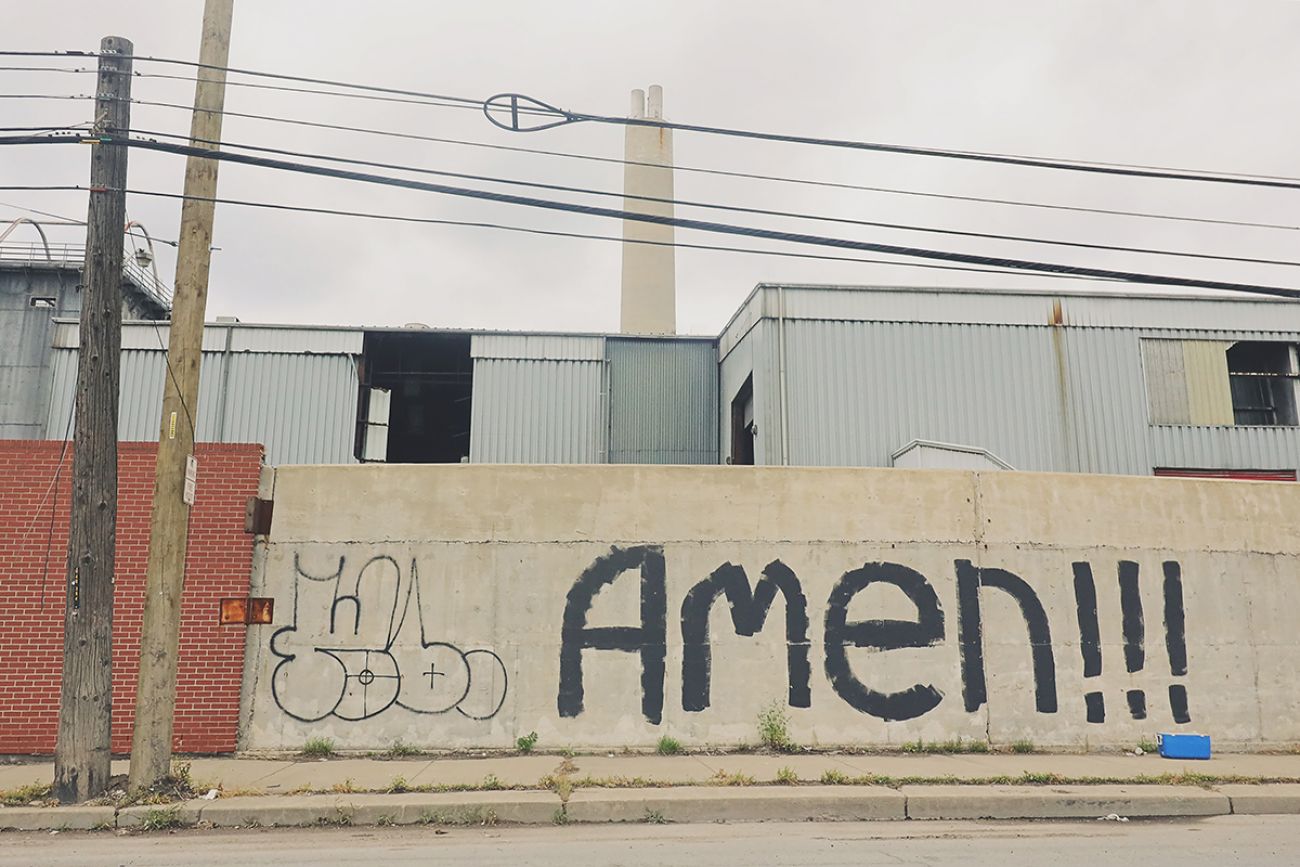Detroit’s incinerator is coming down. Now, neighbors want a say in repairing toxic legacy.


Each day, the now shuttered Detroit incinerator on Russell Street burned thousands of pounds of trash and released emissions that made health issues worse for many nearby residents.
For the Kellys, several family members developed severe asthma, causing missed days of work and frequent hospital visits.
“It was horrible. You could see the smoke in the air,” said Angie Kelly, 52, a mother, grandmother to 18, and a preschool program teacher at Wayne State University.

As a baby, Kelly’s son had severe asthma and was hospitalized for weeks in an intensive care unit. Managing his asthma over his lifetime, she often missed days, even weeks of work. Now, her grandson has asthma too, as do several others in the family.
Related:
- Michigan anglers fear fishing deal with tribes could hurt their interests
- Nature reclaims Up North golf courses, as eagles (the feathered kind) return
- On Isle Royale, fate of summer cabins pits nature against family history
Despite strong odors that forced them to stay in their home and caused health issues, the family stayed in the neighborhood because of the schools and affordable housing.
In 2019, the incinerator closed for good, and it will soon be demolished, to the relief of the Kellys and their neighbors. But during the course of its operation, neighborhood childcare and youth centers closed and a new, 2,400-bed jail was built. Some say the incinerator systematically destroyed the neighborhood’s fabric over its 33-year presence and residents want to see something of benefit in its place.
While praised by many, the demolition has raised a host of other concerns about what the site’s future will hold, what potential revenue received by the city will be used for, and whether dust and other contaminants released from tearing the facility down will further affect neighbors.
The city has sought to reassure Detroiters that they will protect neighborhoods from contamination and include community voices in the next steps. But advocates say there has been a lack of public engagement around the process so far. After suffering for decades, those in the surrounding neighborhood say they want the space turned into something to help make up for the harm caused – a health center, greenspace, or a youth center.
The incinerator should be replaced with “anything having to do with the kids,” Kelly said. Within five miles of the former incinerator there are close to 77,000 children, according to Breathe Free Detroit.
“My kids had that type of stuff when they were coming up, they had all these things to go to. All these little centers for the kids – they’re gone,” added Kelly, pointing to the closure of the Brewster Wheeler Recreation Center, Stone Pool Park and other nearby opportunities for youth. “They need a place to go.”
Contamination concerns
Pre-demolition work has begun on the inside of the facility. Tyrone Clifton, director of the Detroit Building Authority, which is overseeing the demolition, said the goal is to have most of it down by the end of the year. Although, he said, demolishing the stack could take until early 2023. The tear down should proceed from west to east, meaning residents in the Poletown East neighborhood will have a bit more distance from the earliest phases of the work.
Clifton referred to the incinerator as a “fairly clean site” despite its reputation for regularly exceeding pollution limits or producing unpleasant odors. Nick Leonard, executive director for the Great Lakes Environmental Law Center, said asbestos and other contaminants in the facility itself could be less of a concern because it was opened in 1986 after some controls for asbestos and other toxic building materials had already been implemented.
But fly ash, which can be windborne, and bottom ash from incinerators can discharge various toxins including heavy metals, dioxins and PCBs and research has found that some of those pollutants can contaminate soil, water and vegetation.
An environmental consultant working with the city’s Buildings, Safety Engineering and Environmental Department (BSEED) performed soil testing at the incinerator site and Clifton said remediation won’t be needed. But KT Andresky, a Poletown East resident and campaign organizer for Breathe Free Detroit, said her group would like to perform its own soil testing and remains concerned about any contamination from the burning of refuse that may have left residue on the soon-to-be demolished structure.
Activists and residents have requested copies of the soil tests conducted by the city, but have not received them. BridgeDetroit and Planet Detroit also submitted a Freedom of Information Act request to the city for the information.
It’s unclear how much of this toxic material might cling to the incinerator or remain in the soil. But, at the very least, the demolition raises concerns about more dust and particulate matter from the tear down impacting a community that, like the rest of Detroit, already suffers from above average rates of asthma.
“Anytime you have sort of a demolition project like this you’re concerned about dust from the demolition getting to nearby residents and it being unsafe for any number of reasons,” Leonard said. However, he added that this is usually only an issue within a few hundred feet of the demolition and there are no residents living that close.
Clifton said Detroit-based Homrich will be conducting the demolition work and removing asbestos-containing materials prior to razing the structure. The firm will use the “wet method” to reduce dust, spraying down materials consistently to keep particle pollution in place. An environmental consultant, he said, will work with the BSEED to conduct air monitoring during the demolition process.
A 2019 presentation from Breathe Free Detroit pointed to the demolition of the Hanford nuclear incineration facility in central Washington state as a potential road map for Detroit. There, chemical fixatives were used prior to demolition to limit the movement of contaminated dust, but Detroit has no plans to use such fixatives.
Hosam N. Hassanien, an environmental specialist and program manager for BSEED, described fixatives as “potentially harmful chemicals.”A water-based rubber adhesive was used in Hanford and although it’s unclear exactly which type was applied, some of these fixatives contain volatile organic compounds and other harmful substances.
Andresky said she would like to be notified prior to demolition, the same way neighbors are alerted when a house is being torn down. She said this allows residents to protect themselves and their children from dust and pollutants that may be generated.
“I’ve had to cover my gardens multiple times from demolitions that happened near me. And this facility is just humongous compared to a house,” she said. Andresky also expressed concerns about students at the nearby Golightly Education Center and workers at the city’s Department of Public Works yard.
At a May press conference announcing the incinerator’s demolition, Melia Howard from Detroit’s Department of Neighborhoods volunteered to act as a community liaison and address concerns around the decommissioning of the facility. But Andresky said she hasn’t heard from the department since early June. City officials didn’t respond to requests for information on community engagement efforts.
Clifton said much of the process will look more like a dismantling than a standard demolition. Residential housing, he said, is far enough away from the impact area that door-to-door notifications will not be needed. The “constant water spraying,” he added, will be sufficient to keep dust under control. However, the implosion of the smokestack at the end of the process is likely to create a larger disruption.
“At that point, the closest residential areas will be given information for their awareness,” Clifton said in an email.
‘We need meetings’
Another point of contention between the city and neighborhood advocates is likely to be the $1.3 million Mayor Mike Duggan said would be raised as a result of scrapping materials from the incinerator.
John Roach, a spokesman for the mayor, said that money will go toward operating expenses for the Greater Detroit Resource Recovery Authority (GDRRA), the quasi-public agency that managed the incinerator.
But Detroiters and environmental advocates, like Sandra Turner-Handy, said residents should benefit from those profits and be included in the decision-making.
“Those millions of dollars should be going back into that community because that community has been completely destroyed,” said Turner-Handy, senior policy advisor at the Michigan Environmental Council and a resident of the city’s east side.
“The city should work with residents to decide the best use for the land that the incinerator occupied,” added Turner-Handy, suggesting a health center could be placed there to help redress negative impacts created by the facility.
But the city has signaled it has no plans for such robust community engagement. The city already announced plans for a $5 million animal shelter and an office building for Detroit Animal Care and Control on the site. Clifton said the city also might use some of the land to expand its public works yard.
“In an ideal world, the incinerator would be replaced by a park or something that will try to even slightly undo the damage to the air quality,” said Miles Honey, 24, who grew up near the incinerator. Replacing the incinerator with trees could act as a buffer between the freeway and the neighborhood, while improving air quality, Honey said.
But Honey has little faith in the city to protect residents during the demolition of the facility, given that Detroit let the incinerator operate for decades.
“We need meetings within the community to help guide what happens next on this site,” added Melissa Cooper Sargent, a director for the Ecology Center, an Ann Arbor-based environmental organization instrumental in getting the incinerator shut down.
Having lived within a mile and a half of the incinerator, Sargent said neighbors used air freshener to mask the smells and it kept them from gardening, playing outside, and enjoying the neighborhood.

“You would just go back inside,” she said. “You wouldn’t even want to be outside.”
Sargent echoed Turner-Handy, saying she would like to see “a free health clinic for all the people that are still suffering from asthma or heart conditions as a result of all the pollution that was breathed in, that was in our air.”
“It’s a delicate balance between making sure that the people who have lived through the pollution for the past 30, 40 years that the incinerator was burning, are supported and helped so that they can stay,” she said. “We don’t want this community to just all of a sudden be gentrified, because the incinerator is gone. We want it to be a good healthy community for everyone, especially those who have been here.”
After years of watching the neighborhood decline, while prices go up, the Kelly family believes it might be time to move out of the neighborhood. When Angie Kelly first moved into her two-bedroom apartment on Chrysler Drive in 2011 she paid $449. Then the rent went up to $559. Now it’s $720, she said.
“Anything they build over there should have something to do with the kids’ health, from every age.” she said.
The neighborhood’s most noticeable feature, the jail, she added, sends the message to neighborhood kids: “‘Okay, you don’t act right, you’re going to be in jail over there,’” she said. “So put a center for them to act right.”
BridgeDetroit and Planet Detroit partnered to publish this story.
Michigan Environment Watch
Michigan Environment Watch examines how public policy, industry, and other factors interact with the state’s trove of natural resources.
- See full coverage
- Subscribe
- Share tips and questions with Bridge environment reporter Kelly House
Michigan Environment Watch is made possible by generous financial support from:
Our generous Environment Watch underwriters encourage Bridge Michigan readers to also support civic journalism by becoming Bridge members. Please consider joining today.
See what new members are saying about why they donated to Bridge Michigan:
- “In order for this information to be accurate and unbiased it must be underwritten by its readers, not by special interests.” - Larry S.
- “Not many other media sources report on the topics Bridge does.” - Susan B.
- “Your journalism is outstanding and rare these days.” - Mark S.
If you want to ensure the future of nonpartisan, nonprofit Michigan journalism, please become a member today. You, too, will be asked why you donated and maybe we'll feature your quote next time!




